- Qualcomm Launches Snapdragon 4 Gen 2 Mobile Platform
- AMD Launches Ryzen PRO 7000 Series Mobile & Desktop Platform
- Intel Launches Sleek Single-Slot Arc Pro A60 Workstation Graphics Card
- NVIDIA Announces Latest Ada Lovelace Additions: GeForce RTX 4060 Ti & RTX 4060
- Maxon Redshift With AMD Radeon GPU Rendering Support Now Available
Intel Core 2 Extreme QX9770 Performance Preview

We took a look at Intel’s first 45nm desktop offering a few weeks ago and already have a preview of it’s successor. The QX9770 is equipped with a 3.2GHz frequency and is the first Intel CPU to support a 1600MHz Front-Side-Bus. Read on to see how it compares to the rest of our fleet.
Page 4 – Multi-Media: DivX 6.7, TMPGEnc 4.4
It’s time to get our hands dirty with manual benchmarks… true real-world tests! To start off our battery of multi-media tests, we will be taking a look at two video encoding applications that both benefit from SSE4, DivX and TMPGEnc.
DivX 6.7
The DivX encoder has supported SSE instruction sets to some degree in the past, but beginning with 6.6.0, SSE4 support has been added in the form of “Experimental Full Search”. Although I have been unable to see quality differences between the original encoding method and this new algorithm, I am told that overall quality should prove better with the newer method. The downside is that the newer process takes longer than a standard process, but that’s where the benefits of SSE4 come into play.
When using DivX 6.6.0+, you will notice the Experimental Full Search option available under the Codec tab, which is left at Disabled by default. This, as we found out, is a good thing since it does indeed take longer overall. If you are a media enthusiast who cares a lot about quality and doesn’t mind the extra wait, then this might be the route to take. The end result may vary depending on certain factors, such as original video codec, original video quality and video length.
Using the default options, the differences are small. Our QX9650 did prove faster overall (over the QX6850), but it was just over 4%. We decided to stick with our Experimental Full Search testing here, since we have a Nero Recode test coming up with takes care of a similar “stock” option.
For our testing, we are using a 0.99GB high-quality DivX .AVI of Half-Life 2: Episode Two gameplay. The video is just under 4 minutes in length and is in 720p resolution, which equates to a video bit rate of ~45Mbps, not dissimilar to standard 720p movies. We converted the video two different ways.
First, we encoded the video at the same resolution but a lower quality, so as to achieve a far more acceptable file size (~150MB). The second method is encoding of the same video, but to a 480×272 resolution, similar to what some mobile devices use. This last method is not entirely realistic as it’s unlikely the exported video would work on such a device, but the test is to see the benefits of SSE4 in general. Though DivX is the only popular codec to utilize SSE4 at this time, many more should offer support in the new year, making these results relevant.

It’s tests like this that show the true benefits of a Quad-Core processor. The Dual-Core CPUs fall so far behind, it makes the decision on whether or not a Quad-Core is worth the money a whole lot easier. As expected, the QX9770 performed 5% faster than our QX9650.
TMPGEnc 4.4 Express
TMPGEnc XPress is a great application for being able to take a variety of video types and convert them to numerous different file formats for use elsewhere, such as DivX, H.264, QuickTime and HDV. Like DivX above, TMPGEnc 4.4 and onward supports SSE4.
In our QX9650 review a few weeks ago, we mentioned that the developers of TMPGEnc told us that 4.4 Express would not be available for customers until 2008. They have since scrapped that idea, as the program is now available for purchase and upgrade on the official website.
Since we’ve tackled DivX AVI already, for this test we will be taking a 1:16 video which weighs in at 1GB and export it to an MPEG file at 1440×1080 resolution, 29.97fps.

SSE4 is a huge leap for video encoding, which can be seen when comparing the two new processors to our QX6850, which was top-of-the-line just this past summer. Through multiple runs, TMPGEnc on the QX9770 proved 6 – 8 seconds faster (I kept the average) than what the QX9650 could muster, which may be due to the faster FSB, but a lot more testing will need to be completed before concluding on that idea.
Next, we will be taking a look at more video encoders that do not take advantage of the new instruction set, Nero and After Effects.
Support our efforts! With ad revenue at an all-time low for written websites, we're relying more than ever on reader support to help us continue putting so much effort into this type of content. You can support us by becoming a Patron, or by using our Amazon shopping affiliate links listed through our articles. Thanks for your support!







